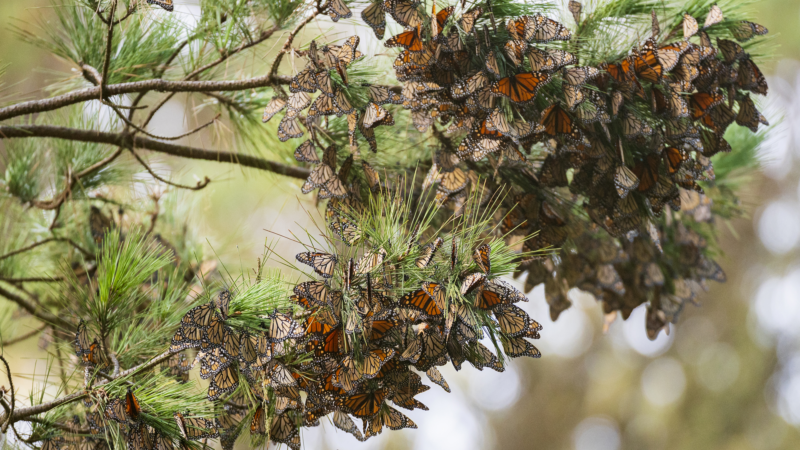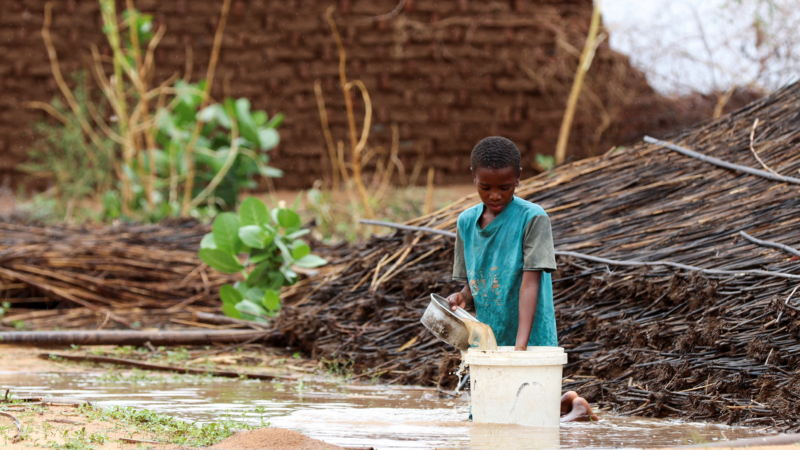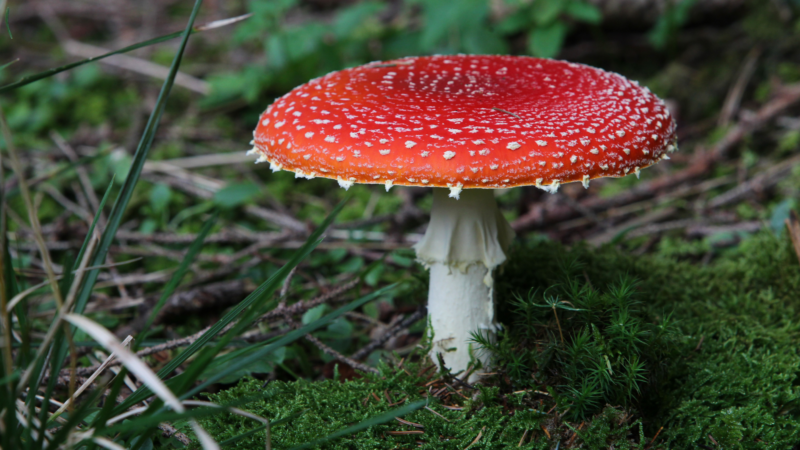How do you protect a species that lives across a continent? Monarch butterfly decision may soon try
One of the most recognizable and widely dispersed insects in North America may soon be headed for protections under the Endangered Species Act.
In early December, federal wildlife officials will decide whether the monarch butterfly, which pollinates plants and flutters through backyards in nearly every U.S. state, is deserving of federal protections.
The decision comes after a decade of efforts by wildlife groups, ecologists as well as non-scientists, who have documented declining monarch populations. And a diverse network of monarch enthusiasts, conservation efforts and landowners are anxious to see whether or how the federal government plans to protect the widespread monarch.
“I think for the general public and for a lot of scientists, it [might] feel kind of strange to have formal protections for something that spans the continent and reaches very high numbers in the summer,” said Matt Forister, a plant and insect ecologist at the University of Nevada, Reno. “But I think that’s a sign that the world is in that state, like the threats are that severe.”
“It’s a new frontier,” he said.
The U.S. Fish and Wildlife Service (FWS) said if protections are still deemed necessary (in 2020 the agency said they were warranted but precluded by higher priorities), it plans to submit a proposed rule to the Federal Register by Dec. 4, 2024. That rule would still be subject to public comment and possible revisions before taking effect.
The expectation from many monarch experts is that FWS will propose to list the monarch butterfly under the Endangered Species Act as threatened – not endangered – with accommodations for some of the people and industries that interact with the migrating species day-to-day.
During their migration, monarchs depend on flowering plants and milkweed, often found on private land. State, local and private efforts are underway to plant and protect milkweed. Monarch advocates hope a listing would better coordinate those efforts and give them a sizable boost, but there are concerns it could also spoil goodwill.
“I think there’s a big concern amongst farmers in particular,” said Brigit Rollins, a staff attorney at the National Agricultural Law Center. “We’ve done all this work we’ve been trying to do right by [monarchs], but maybe now we’re going to be in a position where our good work makes it actually harder for us once the species is listed.”
An incoming Trump administration also muddies the water. The previous Trump administration postponed the decision to list the monarch and rolled back some endangered species protections.
Monarch populations have been declining for decades
Alarm bells have been going off for those following monarch populations for years.
Monarch butterflies migrate over generations – their offspring, or great-great-great offspring completing the journey – so their populations can fluctuate greatly.
“There’s a lot of noise in the data,” said Cat Darst, a wildlife biologist and assistant field supervisor with FWS, who’s helping with the agency’s species status assessment for the monarch. “You can’t just look at one good year or one bad year. You have to look at data over time.”
The overall trend has been pretty clear, she said. “And that is down.”
Eastern monarch populations, which migrate between Canada and overwintering sites in Mexico, are estimated to have declined by more than 80 percent since the 1990s. Counts at overwintering sites on the California coast estimate that Western monarch numbers have plunged by more than 95 percent since the 1980s.
“We are seeing staggering declines,” said Cheryl Schultz, a butterfly ecologist at Washington State University.
There are three prominent drivers of the declines: habitat loss, pesticides and climate change. Overwintering grounds on the California coast and Mexico have been destroyed. Milkweed plants, which monarch larvae and caterpillars feed on, have been torn out for sidewalks, tennis courts and crops. Some of the flowering plants that remain are covered in harmful pesticides. Worsening wildfires, droughts and heatwaves are putting even more habitat at risk.
“You want to have an overall landscape that supports your butterflies so [their populations] can be bouncing way up high and not bouncing so low that when they crash, they’re not able to come back up,” Schultz said.
In 2014, wildlife groups petitioned FWS to protect the monarch butterfly under the Endangered Species Act. In 2020, after years of litigation from the Center for Biological Diversity, the agency declared that the species was deserving of federal protections, but those protections wouldn’t be given because of higher priorities. After more litigation, FWS was mandated by a court to make a new determination by early December 2024.
Darst said the agency intends to meet that deadline and make a new determination but could not speculate as to what it will decide.
“One of the coolest things about the fact that monarchs are kind of everywhere is that everyone can get involved with conservation. And there’s not a species where everyone can get involved,” she said. “One of our goals at the U.S. Fish and Wildlife Service is to maintain that magic for the public.”
The difference between threatened and endangered
The expectation from many following the process is that FWS will propose to list the monarch butterfly as threatened – not endangered.
A species listed as endangered gets the full suite of federal protections. It’s illegal to kill, capture, harass or harm one. A threatened species doesn’t automatically get the same protections. Federal wildlife managers can tailor protections to allow some activities that might harm, harass or kill a threatened species to continue.
“We really want to see some common sense middle ground about exempting activities that are beneficial,” said Emma Pelton, senior endangered species biologist at the Xerces Society for Invertebrate Conservation, one of the groups that’s been pushing for federal protection. “This is a unique animal. It’s in classrooms, it’s in homes, it’s in gardens, it’s used in educational outreach. So we don’t want to see that taken off the plate.”
But it’s also important, she said, that a ruling doesn’t exempt so many activities that it makes the protections ineffective at stopping monarch declines.
“I’m really interested in how the service strikes that balance,” Pelton said. “And I think this is where it will be a little bit groundbreaking – and hopefully in a really good way. How do we get large-scale landscape conservation moving without creating a lot of regulatory fear?”
The biggest fears may come from the agricultural community, which has a lot at stake.
Rollins, who talks to farmers in the heartland of the U.S., said if FWS designates wide areas as critical habitat for monarch butterflies it would impact where farmers plow and plant. A listing could also possibly limit their use of insecticides and herbicides.
“There’s a lot of concern about how listing the monarch butterfly could impact use of pesticides,” she said.
Interest groups on every side of the issue are planning to closely read the proposed rule and flag concerns during the 60-90-day public comment period that follows. A final rule likely would be published later in 2025.
Forister said it may be easy for people to look at the plight of the monarch butterfly and think the federal government should be focused on species with smaller ranges.
“That’s not the future,” he said. “The threats are so widespread now that it’s even affecting widespread species so we got to take this on. Conservation on a large-scale, that’s what we got to figure out how to do as a society.”
Transcript:
MARY LOUISE KELLY, HOST:
The monarch butterfly is one of the most recognizable insects in the country. Its orange and black wings can be spotted in nearly every U.S. state. And yet soon, federal wildlife officials will decide whether these butterflies should be listed under the Endangered Species Act. NPR’s Nathan Rott reports.
NATHAN ROTT, BYLINE: The monarch butterfly presents a bit of a paradox. On one hand, yeah, you can pretty much find them anywhere in the continental U.S.
KAREN SINCLAIR: One up there?
ROTT: There’s one right there.
SINCLAIR: Oh, yeah, there is one right over there. That’s a good sign.
ROTT: Like I did while talking to Karen Sinclair, a biologist at the U.S. Fish and Wildlife Service at a park in Southern California. But…
SINCLAIR: But we’re seeing less monarch butterflies.
ROTT: …There are fewer of them overall. Sinclair trains volunteers to count monarchs every year in Ventura at places like this park, where the migrating insects reliably cluster come winter.
SINCLAIR: And the number of times I have had the locals walk up to us and they go, oh, what are you doing? We’re like, oh, we’re counting monarchs. The monarchs are here. And, like, oh, my gosh. I used to see monarchs all the time when I was a kid, you know? You could see them just dripping off the trees. And I didn’t think they were here anymore, you know? I haven’t seen them like that in a long time.
ROTT: There are two big populations of monarch butterflies in the U.S. The eastern population, which migrates between overwintering sites in Mexico to Canada, has dropped by more than 80% since the ’90s. For the western population, which migrates between the California coast and the Mountain West…
SINCLAIR: Now there’s less than 5% of what there used to be.
ROTT: The decline has spurred countless conservation efforts by states, communities, tribes, wildlife groups and landowners all over the country. But, says Emma Pelton…
EMMA PELTON: But there’s been really good evidence that we are not scaling to the levels that we need for recovery.
ROTT: Pelton is an endangered species biologist at the Xerces Society for Invertebrate Conservation. In one of the groups, it’s been calling for the U.S. Fish and Wildlife Service to list the monarch butterfly as threatened, not endangered.
PELTON: Yeah. I don’t think anyone has argued for endangered. I don’t think it qualifies.
ROTT: Which is an important distinction because when a plant or animal is listed as endangered, it gets the top level of federal protection. Like, this species is nearly extinct. Do not touch or mess with it. If a species is listed as threatened, the protections can be a little more flexible to accommodate for the people interacting with the species, which Pelton says for the monarch is somewhat necessary.
PELTON: We really want to see some common-sense middle ground about exempting activities that are beneficial. This is a unique animal. It’s in classrooms. It’s in homes. It’s in gardens. This is something used for education and outreach. So we don’t want that to, you know, be taken off the plate.
ROTT: And she doesn’t want a potential listing to hamper existing conservation efforts. And that’s the challenge. Monarch butterfly populations are declining for three main reasons – habitat loss, the use of pesticides and climate change. So, perhaps unsurprisingly, when Brigit Rollins, a staff attorney at the National Agricultural Law Center, talks to farmers in the heartland, people who she says are working to conserve monarchs…
BRIGIT ROLLINS: There’s a lot of concern about how listing the monarch butterfly could impact use of pesticides.
ROTT: And how it could impact where they plow or plant. Rollins says she’s expecting the Fish and Wildlife Service to recommend listing the monarch when it makes its decision in early December. But she notes it would only be a proposed rule, subject to public comments, revisions and, soon, a new presidential administration.
ROLLINS: We know that during the Trump administration, the administration was interested in rolling back a lot of environmental regulations.
ROTT: Including many long-held aspects of the Endangered Species Act.
ROLLINS: So I would not be surprised to see that again.
ROTT: Still, advocates and scientists like Matt Forister, a plant and insect ecologist at the University of Nevada, Reno, are excited to see how the federal government proposes to protect an insect that lives practically everywhere because, he says, it’s necessary.
MATT FORISTER: We all grew up with this idea that there – you know, there’s National Parks, right? And, like, they’ve got a fence around them, and that’s going to be fine. But nothing’s fine now, right? All threats are completely pervasive now, and we got to deal with that.
ROTT: We’ve got to figure out, he says, how to do conservation at a large scale. Nathan Rott, NPR News, Ventura, California.
(SOUNDBITE OF KACEY MUSGRAVES SONG, “BUTTERFLIES”)
Sudan’s biggest refugee camp was already struck with famine. Now it’s being shelled
The siege, blamed on the Rapid Support Forces, has sparked a new humanitarian catastrophe and marks an alarming turning point in the Darfur region, already overrun by violence.
FDA approves weight loss drug Zepbound to treat obstructive sleep apnea
The FDA said studies have shown that by aiding weight loss, Zepbound improves sleep apnea symptoms in some patients.
Netflix is dreaming of a glitch-free Christmas with 2 major NFL games set
It comes weeks after Netflix's attempt to broadcast live boxing between Jake Paul and Mike Tyson was rife with technical glitches.
Opinion: The Pope wants priests to lighten up
A reflection on the comedy stylings of Pope Francis, who is telling priests to lighten up and not be so dour.
The FDA restricts a psychoactive mushroom used in some edibles
The Food and Drug Administration has told food manufacturers the psychoactive mushroom Amanita muscaria isn't authorized for food, including edibles, because it doesn't meet safety standards.
The jury’s in: You won’t miss anything watching this movie from the couch
There's been a bit of consternation flying around about the fact that the theatrical release of Juror #2, directed by Clint Eastwood, was very muted. But this movie is perfect to watch at home.







